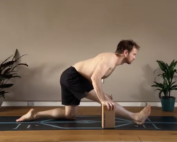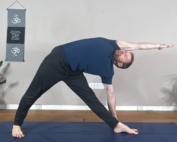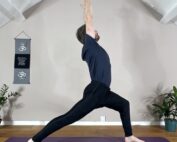
Discover the Steps and Benefits of Bridge Pose (Setu Bandhasana)
Hello! I’m Dav Jones, yoga teacher and teacher trainer and I love sharing with you my love for the asana practice. Today, we’re going to talk about Bridge Pose – Setu Bandhasana. In this blog, we’ll learn what the Bridge Pose is, explore different variations, and discover the great benefits of bridge pose. I’ll also give you some tips to help you practice safely and effectively. Whether you’re new to yoga or looking to improve your technique, this guide is here to help. Let’s get started.
What is Bridge Pose (Setu Bandhasana)?
Bridge Pose, or Setu Bandhasana, is a yoga pose where you lie on your back and lift your hips up towards the ceiling, creating a bridge shape with your body. This pose helps stretch your chest, neck, and spine while also strengthening your back, glutes and legs. It’s a great way to improve the mobility of your spine as well as bring stability to your hips and the sacrum at the base of your spine.
Bridge Pose (Setu Bandhasana) Basics
- Sanskrit: Setu Bandhasana
- Pronunciation: Say-too Bahn-dah-sah-nah
- Meaning of Setu Bandhasana: “Setu” means bridge and “Bandha” means lock, representing the pose’s structure that resembles a bridge.
- Yoga Level: Beginner to Intermediate
- Pose Type: Backbend
Benefits of Bridge Pose (Setu Bandhasana):
Bridge Pose benefits can enhance both physical and mental well-being. The following are some major benefits of using this position in your yoga practice:
Physical Benefits of Bridge Pose (Setu Bandhasana)
- Strengthens Muscles: Bridge Pose targets and tones the glutes, hamstrings, and lower back.
- Improves Spinal Flexibility: This pose stretches the anterior spine, increasing overall flexibility and mobility in spinal extension.
- Opens the Chest: By expanding the chest and lungs, Bridge Pose stretches the connective tissue at the anterior chest which can help with respiratory function.
- Can Help to Release Tension in Lower Back: Bridge Pose can help to alleviate tension and tightness in the lower back.
- Stimulates Abdominal Organs: The pose stretches the abdominal muscles, and massages the abdominal organs. This can help to stimulate digestion and metabolism.
Mental Benefits of Bridge Pose (Setu Bandhasana)
- Enhances Mood: Backbends are stimulating in nature. This pose stimulates the release of endorphins, promoting an increase in energy levels.
- Improves Focus: Due to the increased blood flow to the head, practicing Bridge Pose can help with cognitive function.
Preparatory Poses for Bridge Pose (Setu Bandhasana)
Before starting Bridge Pose, it’s essential to prepare your body with a few key poses. These preparatory poses will help lubricate your joints, create increased blood flow to the necessary muscles, and help create space in your ribcage for more improved breathing patterns.

1. Cat-Cow Pose (Marjaryasana-Bitilasana)
Move through Cat-Cow to warm up the spine and improve spinal mobility.
Benefit: Increases spinal flexibility and mobility and warms up the back, shoulders and hips, preparing them for Bridge Pose

2. Happy Baby Pose (Ananda Balasana)
Lie on your back and collect your feet, bend your knees towards your armpits.
Benefit: Opens the hips and stretches the spine, preparing the lower back and pelvis for Bridge Pose.

3. Thread the Needle Pose (Urdhva Mukha Pasasana)
Starting in all-fours, thread one arm through to the side, twisting at your thoracic spine.
Benefit: Loosens the muscles connected to the ribcage and mobilises the thoracic spine, creating increased space for breathing and spinal extension for Bridge Pose.

4. Cobra Pose (Bhujangasana)
Lie on your stomach, place your hands besides your chest, contract your glutes and gently lift your chest off the ground, keeping your elbows slightly bent.
Benefit: Strengthens the back muscles and opens the chest, which helps in achieving a fuller expression of Bridge Pose.

5. Boat Pose (Navasana)
Sit on the floor with a bend in your knees soles of the feet on the mat. Keep a bend at the knees and lift your feet off the floor balancing the weight of the body on your buttocks. Support the backs of legs with your hands initially, then slowly practice trying to extend your legs. Release your hands from the legs to further challenge your balance.
Benefit: An excellent pose to strengthen the core and hip flexors in a contracted position. This will aid in allowing the core and hip flexors to lengthen more effectively for Bridge Pose.
Step-by-Step Guide to Bridge Pose (Setu Bandhasana)

Step 1: Preparation
- Lie in supine (on your back): Start by lying flat on your back on your yoga mat.
- Bend Your Knees: Bend your knees and place your feet flat on the floor, hip-width distance apart.
Step 2: Positioning and Grounding
- Finding Stability: Place your feet about hip-width distance apart with the feet placed below your knees. Place your arms alongside your hips.
- Ground through your feet: Press through the heels of your feet and the mounds of the big-toes.
Step 3: Lifting
- Inhale and Lift: On an inhale, press your feet firmly into the floor and slowly lift your hips towards the ceiling.
- Roll Your Shoulders: As you lift your hips, invite the shoulder blades towards each other and externally rotate your shoulder joint to create more space in your chest (refer to image above for clarity).
Step 4: Holding the Pose
- Contract Your Muscles: Engage your buttocks to lift your hips higher. Explore rotating your pelvis by tilting forward and back. Find the suitable tilt that feels spacious in your lower back.
- Breathe: Hold the pose and take several deep breaths, focusing on lifting your hips with each exhale. Keep your head and neck still in the posture.
Step 5: Releasing
- Lower Slowly: On an exhale, slowly lower your hips back down to the mat, one vertebra at a time, until your entire back is resting on the floor.
Step 6: Relaxation
- Rest: Allow your knees to rest against each other, or option to bring your knees into your chest to alleviate any tension that may have accumulated during the bridge pose.
Through these steps, you can safely and effectively perform Bridge Pose and enjoy its benefits.
Tips for Beginners: Bridge Pose (Setu Bandhasana)
Bridge Pose (Setu Bandhasana) is a beginner-friendly yoga pose that strengthens the glutes, hamstrings, and lower back while stretching the chest, neck, and spine. In modern-day sedentary lifestyle patterns, the posterior muscles can often become quite weak, Bridge Pose can help to relieve back tension, and is great in building strength in the posterior muscles of the body.
Here are some tips to help beginners get started and fully experience the benefits of Bridge Pose:
- Start Slowly: Begin with short holds and gradually increase the duration as you build strength and familiarity with the pose.
- Reduce pushing into pain: When in the pose, pay attention to how your lower back feels. Compression of joints is often felt as a ‘dull/ache’ sensation. In reference to Bridge Pose specifically, this compression may be felt in your lower back region.
- Direction of Breath: The area of greatest volume and space obvious in Bridge pose is the front of the chest. Direct your inhale into this region of your lungs/chest.
- Use Props for Support: Place a yoga block under your sacrum or use a yoga strap around your outer thighs to create support and provide additional stability.
- Relax Your Neck: Keep your neck relaxed and avoid turning your head while in the pose to prevent strain.
Bridge Pose Variations
Bridge Pose (Setu Bandhasana) offers several variations to accommodate different levels of flexibility and strength. These variations can help you deepen your practice, target different muscle groups, and keep your routine dynamic. Here are a few common variations:

1. Supported Bridge Pose with Block
Place a yoga block or bolster under your sacrum for support.
Benefits: Provides a gentle backbend, reduces strain on the lower back, and allows for a more restorative version of the pose. This variation is excellent for beginners or those looking for a more relaxing experience.

2. One-Legged Bridge Pose (Eka Pada Setu Bandhasana)
From the traditional Bridge Pose, lift one leg towards the ceiling while keeping your hips lifted and level.
Benefits: It increases strength in the glutes and hamstrings of the supporting leg, improves balance, and enhances hip stability and strength.

3. Bridge Pose – Interlaced Fingers
Interlace your fingers beneath your back and extend your arms, pressing them firmly into the mat to lift your chest higher.
Benefits: Deepens the chest stretch and increases shoulder flexibility. This variation helps to open the chest more fully and increase the extension of the spine.
Contraindications of Bridge Pose (Setu Bandhasana)
Bridge Pose is generally safe, but certain conditions require caution:
- Neck Injuries: Avoid or use support under shoulders.
- Shoulder Issues: Avoid interlacing fingers or rolling shoulders.
- Back Problems: Avoid deep backbends; use support if needed.
- Knee Problems: Be cautious of knee strain.
- Pregnancy: Avoid deep backbends, use gentle inclines.
Final Thought
Bridge Pose (Setu Bandhasana) provides great physical and mental benefits, from strengthening the back and glutes to improving mobility of the spinal column. Once you start to find competency in the traditional Bridge Pose, exploring variations such as One-Legged Bridge can really help you create a strong resilient body.
To explore more yoga poses and deepen your practice, join our mentorship program or connect with Dav Jones Yoga on Patreon for comprehensive classes and personalised guidance.









